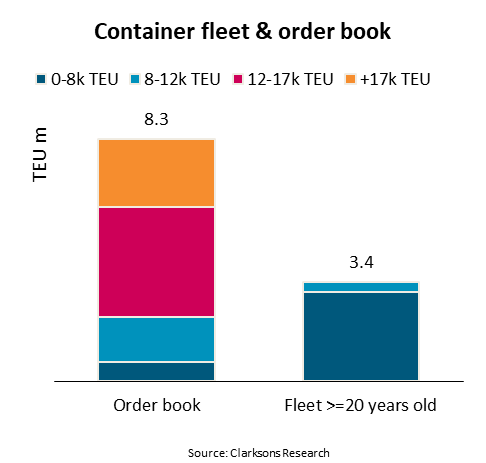“At the end of 2024, the container ship order book was 8.3m TEU, a
new record compared with the previous high of 7.8m TEU in early 2023,” says Niels Rasmussen, Chief Shipping Analyst at BIMCO.
As 4.4m TEU were contracted during 2024, the second highest ever, the
order book grew despite deliveries hitting a new record high of 2.9m
TEU.
“Making up 92% of the order book capacity, ships 8k TEU or larger
dominate the order book. The largest segment, 12-17k TEU, makes up 46%
of the order book capacity,” says Rasmussen.
Shipyards in China have benefitted the most from the last four years’
contracting boom and currently hold 72% of the order book’s 8.3m TEU
while South Korean and Japanese shipyards hold 22% and 5% respectively.
Liner operators control 79% of the order book capacity, significantly
higher than the 61% they control of the fleet capacity. Having already
increased from 56% at the beginning of 2019, liner operators’ share of
fleet capacity is therefore set to continue growing in the coming years.
Though five ships have already been contracted for delivery in 2030, 99%
of the order book will be delivered during 2025-2029. According to the
current delivery schedule, 0.7m TEU will be delivered in 2029 while an
average of 1.9m TEU will be delivered during 2025-2028, peaking at 2.2m
TEU in 2027.
As recycling of ships during the past four years has been limited to 166
ships and 256k TEU, the average age of the fleet has increased 1.4
years since the beginning of 2020. Consequently, the number of ships 20
years old or older has risen, and they now make up 3.4m TEU equal to 11%
of the fleet.
If all ships 20 years old or older are recycled during the next five
years, the fleet will grow to 35.8m TEU by end 2029, assuming no more
ships are contracted for delivery before 2030. That is equal to 16%
growth or average annual growth of 3%. The segments smaller than 8k TEU
would see an average annual contraction of 4% while the segments 8k TEU
or larger would grow on average 7% per year.
“It would require 680k TEU per year to recycle all ships 20 years
old or older during the next five years (the current annual record is
657k TEU) but actual recycling is likely to end lower. As long as ships
cannot fully return to the Red Sea, recycling will likely continue to be
low and at the same time the smaller ship segments tend to be recycled
later than average. Therefore, average annual fleet growth during the
next five years could end higher than 3%,” says Rasmussen.

Source:BIMCO
https://www.xindemarinenews.com/en/market/2025/0109/57950.html

